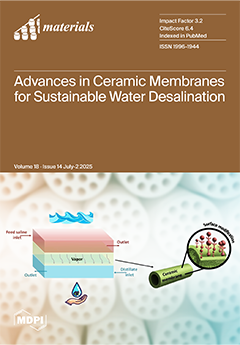Fly ash and slag are widely used as mineral admixtures to partially replace cement in low-carbon concrete. However, such composite concretes often exhibit a greater carbonation depth than plain Portland concrete with the same 28-day strength, increasing the risk of steel reinforcement corrosion.
[...] Read more.
Fly ash and slag are widely used as mineral admixtures to partially replace cement in low-carbon concrete. However, such composite concretes often exhibit a greater carbonation depth than plain Portland concrete with the same 28-day strength, increasing the risk of steel reinforcement corrosion. Previous mix design methods have overlooked this issue. This study proposes an optimized design method for fly ash–slag composite concrete, considering carbonation exposure classes and CO
2 concentrations. Four exposure classes are addressed—XC1 (completely dry or permanently wet environments such as indoor floors or submerged concrete), XC2 (wet but rarely dry, e.g., inside water tanks), XC3 (moderate humidity, e.g., sheltered outdoor environments), and XC4 (cyclic wet and dry, e.g., bridge decks and exterior walls exposed to rain). Two CO
2 levels—0.04% (ambient) and 0.05% (elevated)—were also considered. In Scenario 1 (no durability constraint), the optimized designs for all exposure classes were identical, with 60% slag and 75% total fly ash–slag replacement. In Scenario 2 (0.04% CO
2 with durability), the designs for XC1 and XC2 remained the same, but for XC3 and XC4, the carbonation depth became the controlling factor, requiring a higher binder content and leading to compressive strengths exceeding the target. In Scenario 3 (0.05% CO
2), despite the increased carbonation depth, the XC1 and XC2 designs were unchanged. However, XC3 and XC4 required further increases in binder content and actual strength to meet durability limits. Overall, compressive strength governs the design for XC1 and XC2, while carbonation durability is critical for XC3 and XC4. Increasing the water-to-binder ratio reduces strength, while higher-strength mixes emit more CO
2 per cubic meter, confirming the proposed method’s engineering validity.
Full article






